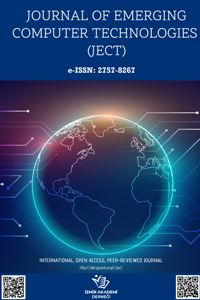Anlamsal Web ve Hastane Randevu Ontolojisi
Anlamsal web, www, web 3.0, ontoloji, hastane randevu ontolojisi
Semantic Web and Hospital Appointment Ontology
Semantic web, www, web 3.0, ontology, hospital appointment ontology,
___
- Atılgan D. (2003)Bilimsel Bilgiye Erişimin Önemi Ve Türkiye’de Eğitim Araştırmaları Veri Tabanı. Akademik Bilişim, Çukurova Üniversitesi.
- Nath K., Dhar S. ve Basishtha S. (2014)Web 1.0 to Web 3.0-Evolution of the web and its various challanges. International Conference on Optimization, Reliabilty, and Information Technology (ICROIT), 86-90, Faridabad, NCR, India.
- Ege B. (2011) Yeni bilgi modelleme ve programlama felsefesiyle semantic web. Bilim ve Teknik dergisi, 2011.
- Emiroğlu B. G. (2009)Semantic web (anlamsal ağ) yapıları ve yansımaları. Akademik Bilişim, Harran Üniversitesi.
- Yıldırım A.ve Üsküdarlı S. (2015) , Bir Ontoloji ile Mikroblog Ortamlarının Modellenmesi ile, İçeriklerin Anlamsal Olarak Erişilebilir Hale Getirilmesi ve Sorgulanması. Akademik Bilişim, Anadolu Üniversitesi.
- Deconta M. C., Obrst J. L. ve SmithT. K.(2003) The semantic web, Wiley.
- Berners-Lee T., Hendler J. ve Lassila O. (2001) The Semantic Web. Scientific American, cilt 285, no. 5, 34-43.
- Gökçearslan Ş., (2011) Semantic Web (Web 3.0) ve Eğitim Amaçlı Kullanımı. Eğitim Teknolojleri Araştırmaları Dergisi, Cilt 2, Sayı 4.
- Berners-LeeT. (1999) Weaving the Web, Harper, New York.
- Öztürk Ö. (2004) Anlamsal Web İçin Bir Ontoloji Ortamı Tasarımı ve Gerçekleştirimi. Yüksek Lisans Tezi, Ege Üniversitesi.
- Seng, J. (2004) Digital Content Exchange https://james.seng.sg/2004/08/27/digital-content-exchange/
- Komesli, M. (2007) Cografi bilgi sistemlerinin OWL ve GML kullanarak anlamsal web ile bütünleştirilmesi. Ege Üniversitesi, Fen Bilimleri Enstitüsü, Doktora Tezi.
- Gruber T. R. (1993) A Translation Approach to Portable Ontology Specifications. Knowledge Acquisition, 5, 2, 199-220.
- Kurtel K. (2008) Web’in geleceği: anlamsal web. Ege Akademik Bakış, 8, 1, 205-213.
- Mishra, T. K. (2003). Semantic web. . Rapor, Indian Institute Of Technology Kharagpur.
- Akyokuş S. (2020) Anlamsal Web, Anlamsal Web Dilleri ve Araçları,http://www.edirnevdb.gov.tr/kultur/ppt/anlamsal_web_rdf_dc_owl.ppt, erişim tarihi: 24/06/2020.
- Protégé (2021) A free, open-source ontology editor and framework for building intelligent systems. https://protege.stanford.edu/
- Yayın Aralığı: Yıllık
- Başlangıç: 2021
- Yayıncı: İzmir Akademi Derneği
Anlamsal Web ve Hastane Randevu Ontolojisi
Edge Computing Security with an IoT device
Vehicle Detection with HOG and Linear SVM
Log Analysis with Hadoop MapReduce
Gligor RİSTESKİ, Mihiri CHATHURİKA, Beyza ALİ, Atanas HRİSTOV
